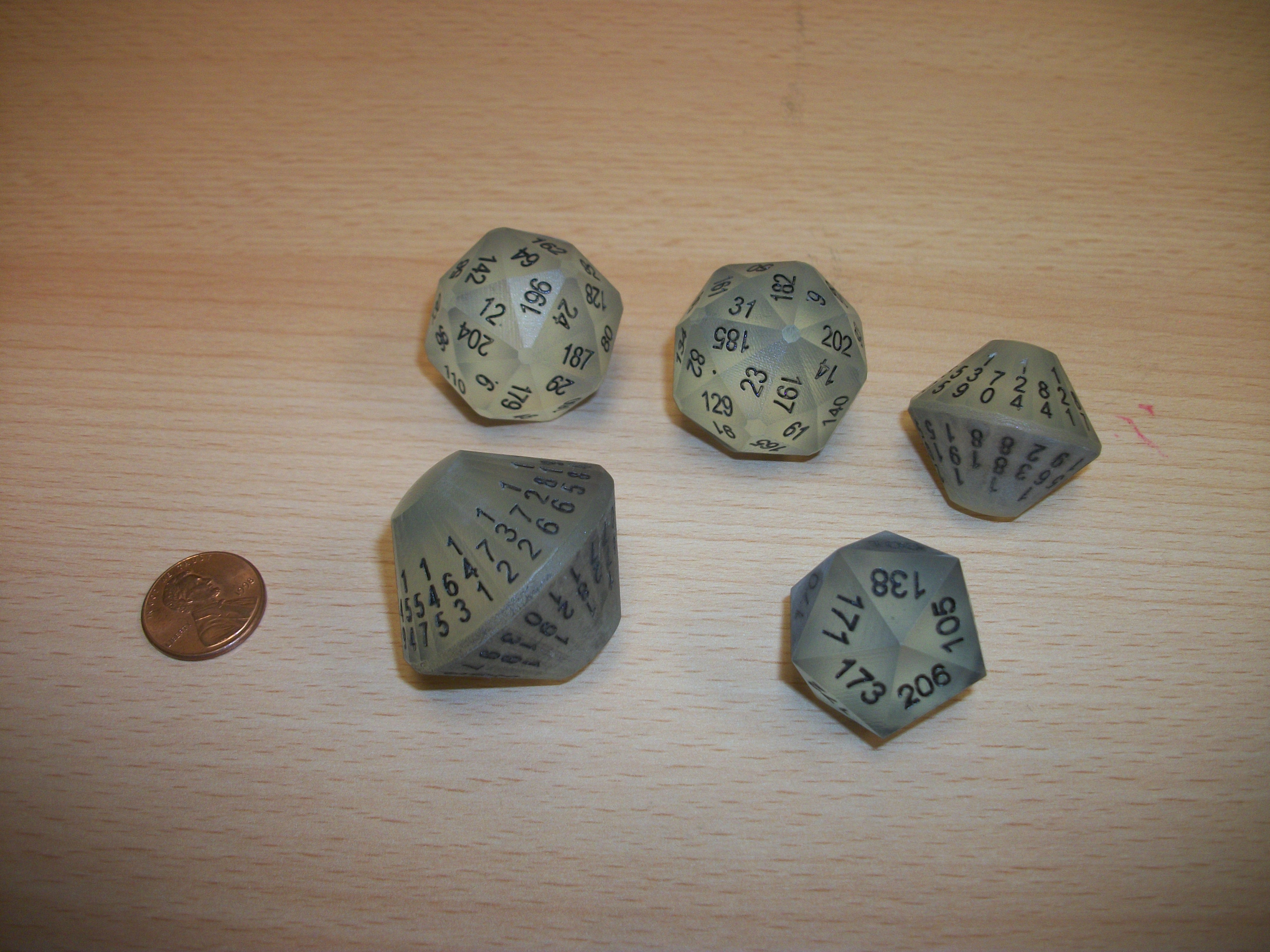This is an old revision of the document!
Significant Solutions
Below is a (more or less) chronological listing of some of the most important Go First Dice sets that have been discovered and brief explanations about their significance.
3d6
acbbacbccaabacbbac
Discovered by Robert Ford (on 10 August 2010). May not have been the first such set; Eric Harshbarger remembers hearsay that a three player set had been sold previously – though he never saw it.
4d12
abcddcbadbaccabdcbaddabccbaddabcdbaccabdabcddcba
Discovered by Robert Ford (on 4 September 2010). Not only “go first fair” but, in fact, “permutation fair”. This is the set that, to this day is sold to the public. Originally sets were engraved and inked by Eric Harshbarger; later they were licensed to be sold at The Dice Shop in the U.S. and Maths Gear in the U.K.
d24+d32+d48+d72+d90
aaaaaaabcdedccccdedcbbbcdedccccdedcbbbcdedccccdedcbaaaaaaaaaaaaaaaaaaaaaaaaaaaaaaaabcdedccccdedcbbbcdedccccdedcbbbcdedccccdedcbaaaaaaaaaaaabcdedccccdedcbbbcdedccccdedcbbbcdedccccdedcbaaaaaaaaaaaaaaaaaaaaaaaaaaaaaaaabcdedccccdedcbbbcdedccccdedcbbbcdedccccdedcbaaaaaaa
Discovered by Paul Vanetti. Though never physically manufactured (and the d90 is not really suitable for such production), this was the first set that demonstrated permutation fairness for 5 players. It was also the first valid inhomogeneous set. This solution was first announced on Byron Knoll's blog.
d20+d24+d36+d48+d72
edcabaccccabacddddcabaccccabacdeeeeedcabaccccabacddddcabaccccabacdedcabaccccabacddddcabaccccabacdeeeeeedcabaccccabacddddcabaccccabacdedcabaccccabacddddcabaccccabacdeeeeedcabaccccabacddddcabaccccabacde
Discovered by Eric Harshbarger (who used the fewest-sides-known 4-player set and “induced” a 5-player set from it using Paul Vanetti's method). The d72 in this set is nearly suitable for a physical die.
5d60 (place-fair)
eabcddbacecabdeedabcdcbaeecbadcabdeebacddcbaeecbadcbadeedbacedabcdabceedabcdcabeecabddbacecabdeebacddcabeedbacdbacedabceeabcdeabcdecabdcbadeebacddcabeecabddcbaeecbaddabcecbadecbadeecabdebacddcbaeedbacdabceebacdedbacdabceecbadcabdeedabcdcabedbaceecabddbaceeabcddcabeecbadcabdeedabcdcbaeedbaceabcdcbade
Discovered by James Grime and Brian Pollock in 2014. This set of five 60-sided dice is “place fair” but not “permutation fair” (though it is tantalizingly close to exhibiting that stronger fairness). It was constructed using an original technique that Grime and Pollock call “binary construction”.
d20+d36+2d48+d54
eacdbbddcbccdbaadaacdbbcbddccdbaeeeeeacdbbddcbccdbaadaacdbbcbddccdbaeacdbbddcbccdbaadaacdbbcbddccdbaeeeeeeacdbbddcbccdbaadaacdbbcbddccdbaeacdbbddcbccdbaadaacdbbcbddccdbaeeeeeacdbbddcbccdbaadaacdbbcbddccdbae

Discovered by Eric Harshbarger (on 4 January 2018). With the largest die in the set having only 54 sides, this was the first 5-player set that actually “worked” (all the dice roll reasonably well and it could be physically produced/used).
5d120
Discovered by Mike Purcell (on 12 December 2022). This set lowered the size of a 5-player homogeneous set to 120 sides. It can be physically produced as there is an isohedral 120-sided geometric solid.
d20+4d36
ecbdaadbcabcddcbadbaccabdeeeeedbaccabdcbdaadbcabcddcbaeabcddcbadbaccabdcbdaadbceeeeeeabcddcbadbaccabdcbdaadbcedbaccabdcbdaadbcabcddcbaeeeeecbdaadbcabcddcbadbaccabde
{{bram-set.jpg
Discovered by Bram Cohen (on 26 December 2022). This set currently holds the records for the 'fewest total sides“ and the “smallest largest die” in the set.

